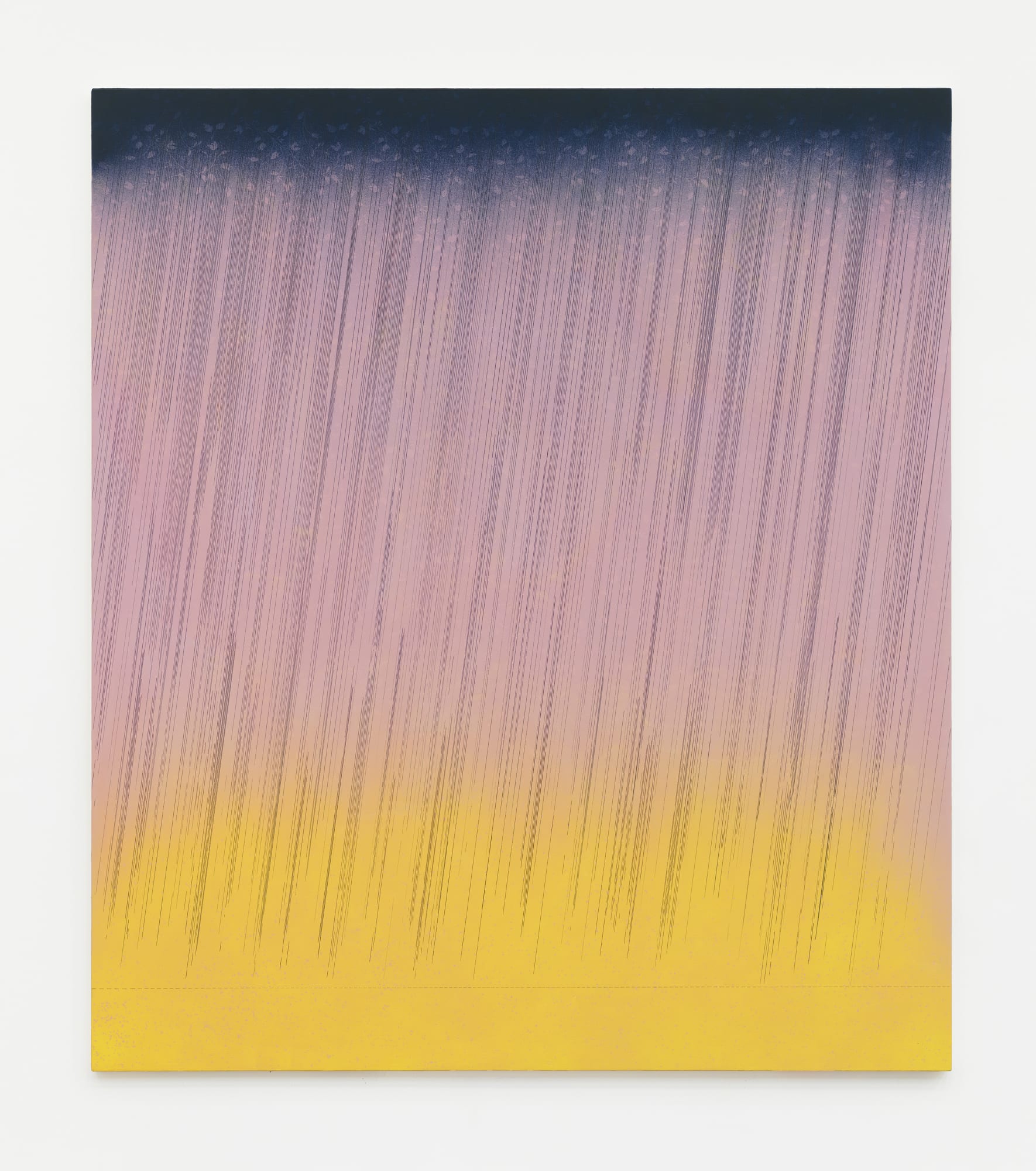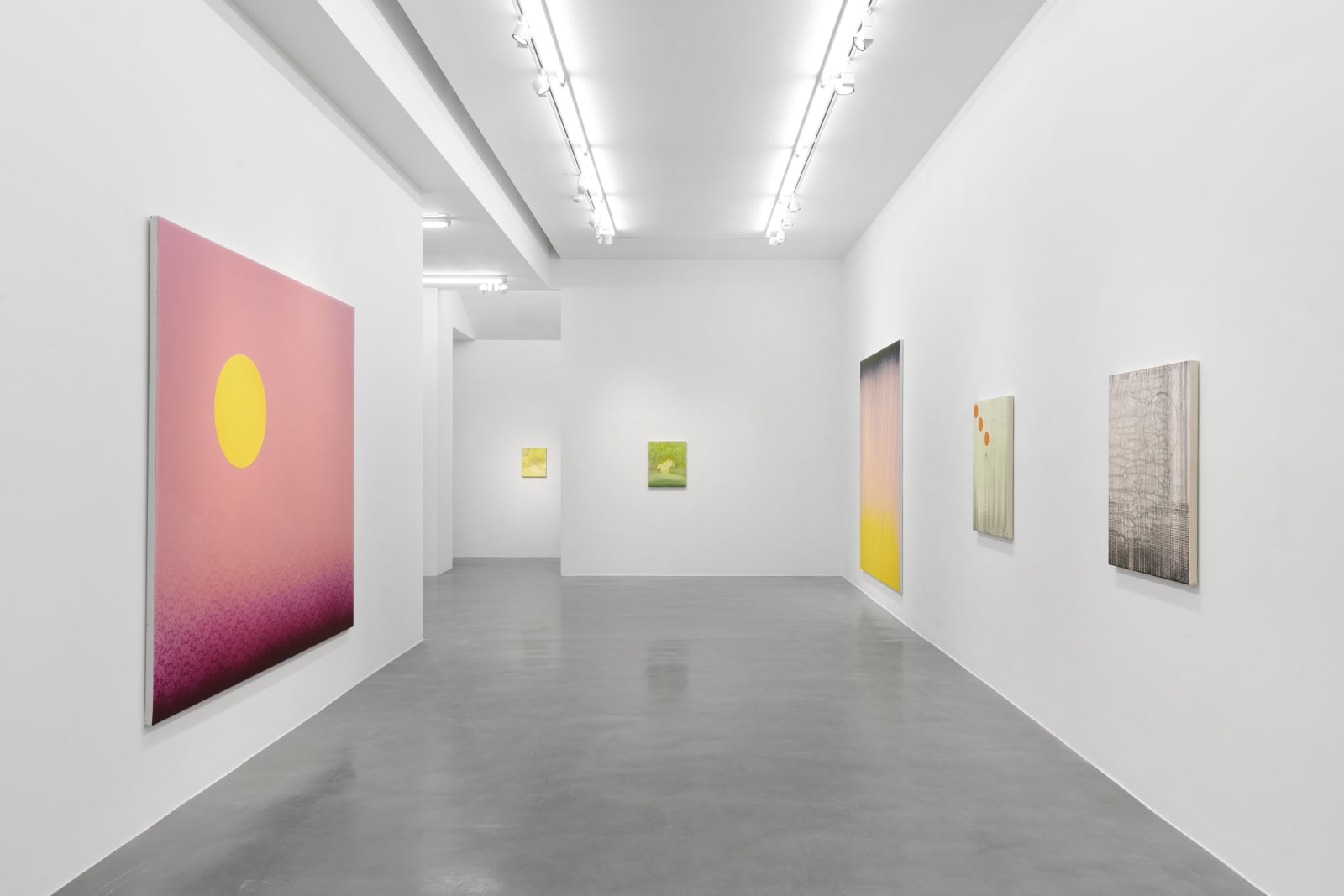RACHEL HOWARD / An Opening on the Other World, from which we Gather the “White Noise”
by Paolo Meneghetti, Aesthetic Critic
Rachel Howard (born 1969) likes to distort the sublimation of painting, for example by applying pigments to the top of the canvas, and then adding paint to it. Thus, it will be gravity that will orient the final representation. When we contemplate a landscape, it “lulls us” through its immensity. It is the perception of the sublime, which resolves all anxiety about orientation by ensuring the eternity of a panorama. But the immensity weighs on us, making us admit our transience. Rachel Howard uses a painting technique that allows a clump between Lucio Fontana’s cuts and Daniel Buren’s strips. If there was another world, one would first have to feel its contact. Imagine losing the Earth’s gravity: immediately we will commit to lull the “white noise” of the void. In Daniel Buren’s art, the strip is sufficiently controversial to neutralize the presumptions of figurativism. More spontaneously, we know the pictorial technique of dripping. The clump Rachel Howard is interested in would try to “open and close” a hold on randomness. As much as the superficiality of the matter burdens, it would be better for us to intercept its depth.

Rachel Howard Happy Happy Joy Joy, 2021
Oil and archival marker pen on canvas
244 x 213.5 cm (96 1/8 x 84 1/8 in.) Courtesy Simon Lee gallery
Rachel Howard, You Have a New Memory, 2021
Simon Lee Gallery, London
Photo: Ben Westoby 
Rachel Howard WW, 2019-2021
Oil on canvas
61 x 50.8 cm (24 x 20 in.) Courtesy Simon Lee galleryOne could imagine that Lucio Fontana’s characteristic cut would involve, according to Rachel Howard, the entire canvas. It is the wallpaper that one would want to grab, without any slippage of the “naturally” abstract lines. Before we cross the threshold of the other world, we would materialistically “clump” the “white noise” on the background . The decorativism on the unknown would not be perceived, but rather the interception of orientation. There is almost an identifying “carnality”, thanks to the virtuality of the hologram. If the presence of man is secularly dependent on chance, no one forbids us to “jump” our gaze to the horizon. The dripping of the artist, which vertically follows the Earth’s gravity, is replaced by that of the slightly “sandy” immensity, for example from empty words. Rachel Howard often uses the symbol of the circle, giving it a radiance to “feel”. On a more existential level, it seems that some paintings depict a “blow-up” on neural orientations, if we really don’t want to mention the electroencephalogram! The human mind passes through the opening of reason, after having received the dripping from sensation to perception.

Rachel Howard, You Have a New Memory, 2021
Simon Lee Gallery, London
Photo: Ben Westoby According to Gaston Bachelard, the night is perceived in its insinuation. Against that, we would hardly see. A pond has water in its mixing. So the night would slip into it even better. The cloudy day stays on! For Paul Decharme, from a pond monstrous birds would shoot their feathers like arrows. In the cloudy it would be easier to perceive the rough. Edgar Allan Poe imagines that under a sea storm the water has ink, and it’s due to the excretion of a huge cuttlefish.

Rachel Howard, You Have a New Memory, 2021
Simon Lee Gallery, London
Photo: Ben Westoby In other paintings, Rachel Howard uses the clotting gash of blood red. Symbolically, it’s something to scramble about violence. But whoever denounces a crime highlights the “turbulence” within each of us, while the “bestial” impulses are no longer governed. Abstractly, the orthogonal projections would remain lost on the focus of their own “abysses”.

Rachel Howard Laughing Tree, 2021
Oil, acrylic and archival marker pen on canvas
244 x 213.5 cm (96 1/8 x 84 1/8 in.)Nor is it enough to cover them, with a sort of gauze, which above all will cloud the understanding mind. Or the glimpses of primordial carnality will turn to the euphoria of a waterfall, which comes to transfigure the light of contemplative rest. If the spontaneous blossoming of life had a “bucket”, due to the mechanical nature of self-subsistence, we would turbidly “draw” our thoughts from a “jar” with … a fist. It seems that the paintings oscillate in an aesthetic dialectic: between the vegetative state that becomes opaque thanks to the neurons (from green to gray), and the emotional state that becomes metallic thanks to the stars (from red to yellow). How can an orthogonal projection be grouped together? Would we make it gravitate to the astral conjunction? Rachel Howard would paint not only the solar circle, but also the electromagnetic spectrum (where it is more realistic to perceive an influence).

